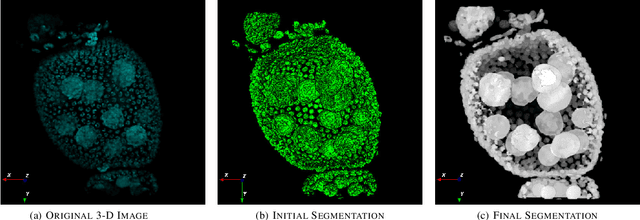Robust Segmentation of Cell Nuclei in 3-D Microscopy Images
Paper and Code
Oct 07, 2021



Accurate segmentation of 3-D cell nuclei in microscopy images is essential for the study of nuclear organization, gene expression, and cell morphodynamics. Current image segmentation methods are challenged by the complexity and variability of microscopy images and often over-segment or under-segment the cell nuclei. Thus, there is a need to improve segmentation accuracy and reliability, as well as the level of automation. In this paper, we propose a new automated algorithm for robust segmentation of 3-D cell nuclei using the concepts of random walk, graph theory, and mathematical morphology as the foundation. Like other segmentation algorithms, we first use a seed detection/marker extraction algorithm to find a seed voxel for each individual cell nucleus. Next, using the concept of random walk on a graph we find the probability of all the pixels in the 3-D image to reach the seed pixels of each nucleus identified by the seed detection algorithm. We then generate a 3-D response image by combining these probabilities for each voxel and use the marker controlled watershed transform on this response image to obtain an initial segmentation of the cell nuclei. Finally, we apply local region-based active contours to obtain final segmentation of the cell nuclei. The advantage of using such an approach is that it is capable of accurately segmenting highly textured cells having inhomogeneous intensities and varying shapes and sizes. The proposed algorithm was compared with three other automated nucleus segmentation algorithms for segmentation accuracy using overlap measure, Tanimoto index, Rand index, F-score, and Hausdorff distance measure. Quantitative and qualitative results show that our algorithm provides improved segmentation accuracy compared to existing algorithms.
 Add to Chrome
Add to Chrome Add to Firefox
Add to Firefox Add to Edge
Add to Edge